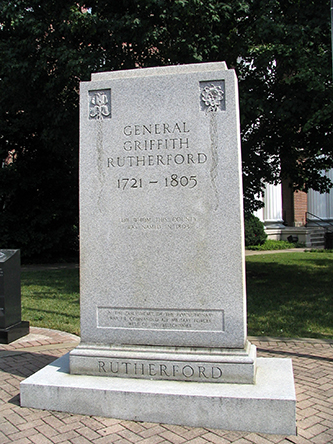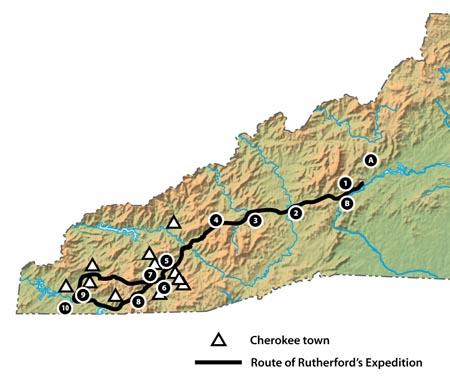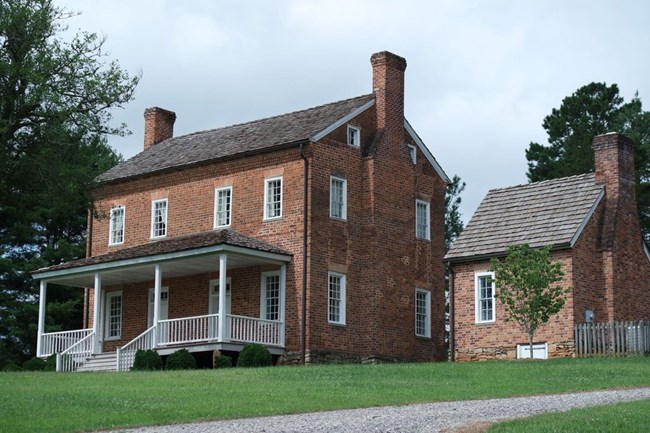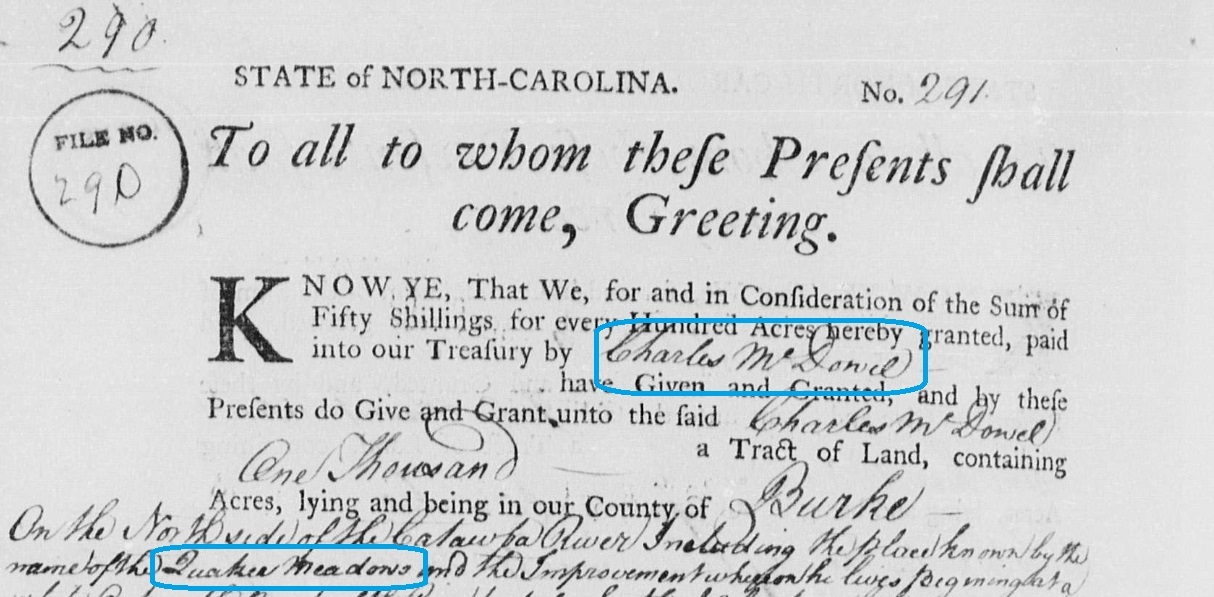Western North Carolina is home to many important events of the Revolutionary War. In 1776, General Rutherford marched through the mountains of North Carolina and destroyed Cherokee villages in what is known as the Rutherford's Campaign, and in 1780, Kings Mountain had a famous militia-only battle between Loyalists and Patriots. But did you know that one site in western North Carolina, Quaker Meadows, was not only involved in both of those events, but also others?
Quaker Meadows is a historic plot of land in Burke County, North Carolina, and is located west of present-day Morganton. Until Burke County formed in 1777, Quaker Meadows was a part of Rowan County. The name "Quaker Meadows" was used to refer to the area beginning on November 19, 1752, according to the notes of Bishop August Gottlieb Spangenberg. White European pioneers arrived in the area as early as 1740, but they were not the first people to live there. At the time of their arrival, the land of Quaker Meadows served as a hunting ground for the Cherokee, Catawba, and Nottoway American Indian tribes. The Catawba and Cherokee tribes had agreed via treaty that the land would have no permanent settlements and would be used for each to hunt freely. White settlements continued to appear on this land, which complicated relations with American Indian people. The French and Indian War further stressed the relationship, and the Cherokee War (1758-1761) was the resulting climax. The Cherokee tribe continually attacked white settlements as a form of resistance to colonization. The British government issued the Proclamation of 1763 after the war to help ease Cherokee fears of land loss. In the post-wars period, an important settlement was founded at Quaker Meadows by Joseph and Margaret O'Neil McDowell.
The McDowells moved from Winchester, Virginia, to the area around 1765. The couple had two sons, Charles and Joseph. They would both serve North Carolina as Patriot (rebels against Britain) militia leaders in the American Revolution. Until their service in Rutherford's Campaign and King's Mountain, their role as militia leaders was to defend western Rowan County from Loyalist (supporters of Britain in the colonies) and American Indian attacks. Some American Indian tribes, like the Cherokee, allied with the British in the American Revolution in order to protect their lands from Patriot settlers like the McDowells. They would attack Patriot settlements to help the British. By the late spring and early summer of 1776, the McDowell settlement at Quaker Meadows was a direct target of these Cherokee raids.
Quaker Meadows (specifically McDowell's Station, a fort in the Quaker Meadows area) was attacked by retaliating British-allied Cherokee warriors on July 2, 1776. The operation was coordinated by British and Cherokee soldiers from North and South Carolina, Virginia, Tennessee and Georgia. They attacked numerous locations all over the frontier, and McDowell's Station at Quaker Meadows was one target. Captain Matthias Barringer was leading a scouting party in the Quaker Meadows area when the group was ambushed by a "Cherokee war party armed with British rifles." The Cherokee suffered an unknown number of losses and killed all members of the party except one, Philip Fry. Other Cherokee raids continued through the summer, and as many as 37 white settlers, and an unknown number of Cherokee soldiers, were killed as a result.
Griffith Rutherford, then a captain of the North Carolina militia, petitioned the Patriot government in Hillsborough for help against Cherokee raids like the one on July 2nd. His letter to the Hillsborough assembly reads:
Honourable Gentlemen,
I am under the nessety of sending you by express, the Allarming Condition this country is in, the Indins is making great prograce in Distroying and Murdering in the frontiers of this county. 37, I am informed was killed last Wedensday & Thursday on the Cuttaba [Catawba] River. I am also informed that Col. [Charles] McDowel with 10 men and 126 women and children is [besieged], in some kind of a fort, with Indins all round them, no help to them before yesterday and they were surrounded Wedensday. I expect the nex account to here that they are all destroyed. … Pray Gentlemen Consider our distress, send us plenty of Powder & I Hope under God we of Salsbury District is able to stand them, but, if you will allow us to go to the Nation, I expect you will order Hillsbourgh District to join Salisbury. Three of our Capitans is killed and one wounded. This day I set out with what men I can Raise for the relief of the Distrest.
Your Humble Servant,
Griffith Rutherford
The Patriot government in Hillsborough sent the western militia to help. The militia repelled the raids, and both sides lost soldiers. The Patriot government wanted to end Cherokee raids on the frontier. Multiple states planned a war expedition known now as Rutherford's Campaign with the goal of destroying Cherokee possessions in western North Carolina. This would end the raids and break the Cherokee-British alliance.
Rutherford's Campaign, was a September 1776 military action commanded by General Griffith Rutherford. North Carolina, South Carolina, and Virginia gathered 2500 soldiers who were led by Rutherford. The expedition marched to homes of the Cherokee people in the mountains of North Carolina. Along the way, the North Carolina branch of the expedition camped at Quaker Meadows before continuing to the mountains. Between September 1 and September 26, Rutherford's Campaign destroyed at least 36 Cherokee towns, and their associated food and supplies. The Cherokee people were left with little food or housing before winter. The sack of the Cherokee villages severely damaged the Cherokee-British alliance and dramatically reduced Cherokee raids on places like Quaker Meadows in western North Carolina.
After Rutherford's Campaign, Quaker Meadows calmed. Raids declined and, in 1780, Charles McDowell was even given a 1000 acre land grant "on the No. side of the Catawba River including the place known by the name of the Quaker Meadow." But, in September 1780, Quaker Meadows would once again become an important place in the American Revolution with the muster of the Overmountain Men.
In 1780, the Revolutionary War moved to the southern states. British authorities believed that many citizens in this region remained loyal to King George III and would rally to fight alongside an invading British force against the Patriot rebels. British major Patrick Ferguson led the British invasion into the far west of the southern colonies. After several unsuccessful skirmishes against the western frontier Patriots (the Overmountain Men), Ferguson threatened to "march this army over the mountains, hang your leaders, and lay waste your country with fire and sword." The threat mobilized resistance to the British. Militia groups of Overmountain Men from Abingdon (VA), Sycamore Shoals (TN), and Wilkes and Surry counties (NC) all mustered (or gathered as an army) at Quaker Meadows on September 30, 1780. Their leaders, like Charles McDowell, met under the "Council Oak" and they created a plan to defeat Ferguson. They camped at Quaker Meadows for the night, and departed the next day to enact their battle plans. About a week later, on October 7, the mustered Overmountain Men defeated British Loyalists at King's Mountain, South Carolina. The victory empowered Patriot resistance. It also forced the British to change strategies for the Revolution in the southern states.
After the Patriot victory at King's Mountain, the militia returned to Quaker Meadows to camp. They brought about 600 Loyalist prisoners from the battle with them, and stayed there from October 15 to October 16. According to one Patriot account, Charles McDowell "rode along the [camp] lines, and informed us the plantation belonged to him, and kindly invited us to take rails from his fences, and make fires to warm and dry us."
Quaker Meadows calmed again after the Battle of King's Mountain. It would remain quiet until Charles McDowell's son, Charles, built the historic Quaker Meadows home in 1812. In 1998, the house was restored to its 1812 appearance by the Historic Burke Foundation. Quaker Meadows and the home is open to the public as part of the National Park Service's Overmountain Victory Trail. The site serves as an important identifier of North Carolina's American Indian and Revolutionary War history.
References:
"Burke Co. File No. 290, Charles McDowel." NC Land Grant Images and Data. https://nclandgrants.com/grant/?mars=12.14.36.292&qid=962500&rn=1 (accessed August 18, 2023).
Clark, Larry R. Indians of Burke County and Western North Carolina. Morganton N.C: TimeSpan Press, 2010.
Lee, Enoch Lawrence. Indian Wars in North Carolina 1663-1763. Raleigh N.C: Carolina Charter Tercentenary Commission, 1963. https://penelope.uchicago.edu/Thayer/E/Gazetteer/Places/America/United_S... (accessed August 18, 2023).
Phifer, Edward William. Burke the History of a North Carolina County 1777-1920 with a Glimpse Beyond. Morganton N.C: E.W. Phifer, 1982.
"Quaker Meadows: Gathering Point for the Overmountain Men." AmRevNC. https://amrevnc.com/quaker-meadows/ (accessed August 18, 2023).
"Quaker Meadows is 'Beshaged'." The Indian Wars: Early Conflicts Between North American Natives and Settlers. January 8, 2017. https://theindianwars.blogspot.com/2017/01/quaker-meadows-is-beshaged.html (accessed August 18, 2023).
"The Captain Charles McDowell, Jr. House at Quaker Meadows." Historic Burke Foundation, Inc. https://www.historicburke.org/capt-charles-mcdowell-jr-house-at-quaker-m... (accessed August 18, 2023).



